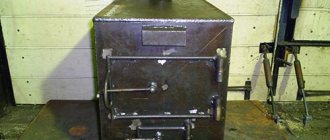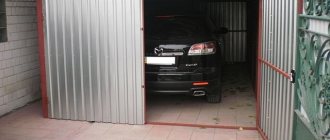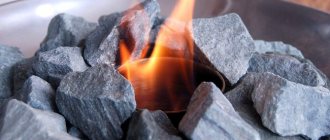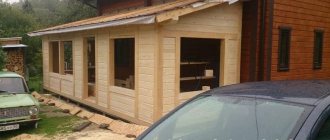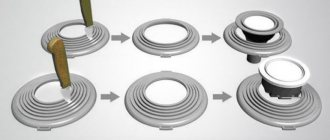Heat guns are one of the most powerful tools for heating a room. They are an analogue of traditional heaters, but with significantly greater power and a convection system that blows out a powerful heat flow. On average, a gas heating gun with a capacity of 10 – 15 kW capable of 20 minutes in a room with an area of 150 m2 raise the temperature by 5 – 10 ℃. Traditional electric heaters simply do not have such power, since only industrial electrical networks can withstand such a load.
Features of using composite gas cylinders
Composite gas cylinders have recently become increasingly popular. This is due to their advantages over their steel counterparts.
- Weight. Almost twice as light as steel.
- Ease of handling. There are comfortable handles.
- Transparency. The fill level can be easily seen.
- Convenient storage. Can be placed one on top of the other and stacked.
- Life time. The service life is practically unlimited.
- Operational safety. It is caused by the absence of sparking and a safety valve and fusible link built into the gas cylinder.
Composite cylinders supplied to the Russian market are produced in the Czech Republic, Norway and India. When purchasing such a cylinder, it is necessary to clarify the connection standard. If the gas cylinder is equipped according to the Russian standard, you can use a regular reducer for the gas cylinder. If the gas cylinder comes with a European connector, then you will need to either order an adapter or purchase an imported reducer. Please note that each additional connection increases the risk of gas leakage.
Additional functions
Additional functions in gas heat guns include:
- Automatic ignition system . It works either from the mains or as a mechanical piezo element. If they are absent, the device is started manually (by bringing a match or any other burning element to the burner nozzle).
- rotation speed adjustment . This functionality allows you to adjust the power of the air flow. For small rooms – less, for large ones – more.
- Adjusting the gas supply . Used to turn on “turbo mode”, when the heating element heats up in literally 10 - 20 seconds. Allows you to start heating the room instantly.
- Availability of additional sensors . These include a gas leak sensor, a gas pressure reduction sensor, a thermostat (responsive to ambient temperature), a position indicator (if the gun accidentally tips over, it blocks the gas supply and the device turns off).
- Thermocouple . Allows the fan to automatically adjust the rotation speed depending on the temperature in the combustion chamber or heating element.
This model has 4 sensors that allow the device to automatically turn on/off to maintain the set temperature in the room
Manufacturers also began to produce automatic gas guns that operate on the principle of conventional electric heaters with a thermostat. That is, they turn on and off automatically, maintaining the room temperature at a given level. However, the response threshold of such devices is high, so you should not count on careful adherence to temperatures down to 0.5 degrees.
Such sensors are responsible for automatically turning off the gun when an emergency occurs. But they fail quite quickly, especially when using low-quality fuel
Video - Gas gun, garage heating (is it worth taking)
Find out how to choose a floor-standing gas heating boiler for a private home in a special article on our portal.
Kinds
The types of gearboxes differ in the following ways:
- View. Post model - for cylinders. Central - for pipelines.
- Working method.
- Connection type.
- Appearance.
- Throughput potential.
- Reduction level. 1 or 2 cameras.
There are household and industrial types. The latter are equipped with pressure gauges.
Since the importance of a reducer for a gas tank is great (safety, stable operation, etc.), then the question of whether a reducer is needed for a gas cylinder disappears instantly.
And when choosing a device, you should take into account the compliance of its dimensions with the needs of the equipment connected through it.
Cylinders with these devices are placed inside or outside the house. In the first situation, the room should have the option of rapid ventilation in case of a dangerous situation.
The outdoor version is safer.
Types of devices according to such criteria as gas flow:
- Acetylene. The gearbox is white.
- Hydrogen. Dark green color of the device.
- Oxygen. The gearbox is blue.
- Propane-butane. Red gearbox.
- Methane. Also red.
What kind of reducer is needed for a gas cylinder? The answer is point 4.
Versions designed for other gases are prohibited for use with liquefied hydrocarbon mixtures.
The characteristics of the device must be equal to those of the cylinder and the device on which it is mounted.
Proper adjustment of the power of the outgoing gas flows is also of great importance. When the parameters exceed the permissible values, the automation in modern gas technology turns it off. If the equipment does not have such protection, an accident may occur.
Gearboxes are also required to be certified.
There are the following standards for connecting to a gas tank (by thread):
- W 21.8 x 1/14 – cylinder type DIN 477/T1. Abbreviated as SP 21.8
- G – pipe-cylinder type. The number after the letter is the template diameter (measurement in inches).
- M – metric. After the letter there are two numbers. The first is diameter. The second is the thread distance (in mm).
For connection, you can use a regular flexible hose. The fitting of the device is wetted with water. A screw clamp is used to secure the connection.
To connect bellows hoses, an adapter with thread is used. It is screwed in to replace the fitting. After which a check takes place - gas is passed through without the devices being turned on. The gas consumption valve is unscrewed and the control screw is turned out. The spring is extremely weakened. When the pressure gauge reflects a smooth development of pressure, the device is not suitable.
Having assembled the system, you need to arrange the flow of gas from the tank to the reducer. You need to rotate the adjusting screw to set the optimal pressure at the outlet section. The contact points are moistened with a soapy mixture. This is a gas leak test.
How to choose a gas gun in a store and what to look for
When choosing a gas gun for domestic use, you should first pay attention to the following parameters:
- Power . It is measured in kW; sometimes manufacturers additionally indicate the volume of heated air per 1 hour of operation. In the first case, the formula is followed: 1 kW per 10 m2 is the minimum. Secondly, it is necessary to calculate the total volume of the room planned for heating with a gun and divide the resulting figure by 2. This will give the minimum power of the gun, with which the room can be heated within 30 minutes of continuous operation of the heater. For example, the volume of air heated by a gun is 300 m3 . Accordingly, it is optimally suited for a room with a volume of 150 m3 (volume and area should not be confused - these are completely different indicators).
- Connection type . This means with a closed or open burner. The first ones are more expensive and they are used for “emergency” heating of residential premises. It is not worth buying them for other purposes. Open ones are the best option for garages, sheds, warehouses and other non-residential premises.
- Presence of automatic arson . In principle, the function is not required. Moreover, piezoelectric elements fail quite quickly, but their presence increases the cost of the gun by almost 10–20% .
- Availability of additional functions . This means adjusting the fan speed, sensor system, thermostats, and so on. All of them help automate the operation of the gun, but manufacturers do not recommend leaving heaters of this type running without supervision. And the presence of those same sensors also increases the final cost of the device. If you need to save money, you can buy a gun without all these sensors.
- Power supply for fan. Available either from 220V or 12V DC. The last option is convenient because the gun can be used as a mobile gun, launching it even in the absence of a household electrical outlet. If such functionality is not needed, then it is better to take it with the simplest 220V motor. Even better - without brushes (such motors are very reliable and durable, but are quite expensive).
Operating principle of a gas gun
Table 1. Key parameters of gas guns that must be taken into account when purchasing.
| Parameter | Recommended value |
| Power | Not less than 1 kW per 10 m 2 of heated room |
| Type of gas the gun operates on | Methane - for connection to the household gas network, propane - for cylinders. There are also “universal” guns, but they are expensive and often break down due to the complex technical design (there are 2 separate valves working at the same time) |
| Auto-arson | It is recommended to take one without automatic ignition - such models are cheaper, their starting is not dangerous |
| Availability of additional sensors | Not necessary. Most of them will not be used by anyone - tested in practice |
| Fan motor power supply | With support for connecting to 12V, buy if the heater will be used as a mobile one. In other cases - only 220V |
| Closed or open burner | Closed - for heating residential premises, open - for everyone else |
An option for using gas guns is for installing suspended ceilings. Under the influence of high temperature, PVC fabric easily stretches, there are no folds or dents left on it
Self-connection: is it possible or not?
Almost all representatives of gas services say that only specialists who receive money for their work have the right to work with gas. However, to avoid unnecessary expenses, it is quite possible to carry out such an operation yourself.
The master will not encounter any special difficulties on the way to his goal. To connect a gas stove, you first need to choose the most suitable location for the tank, and then start organizing the outlet (flexible hose, pipe) to the household appliance.
The only skill required is working with gas keys. But you will have to follow the safety rules for handling gas equipment. Household cylinders can be installed both indoors and outdoors. However, according to fire codes, the ideal place for such equipment is still outside the home.
The kitchen or utility room in this case are not the best alternatives. Of course, when placing the tank outside, you will have to install a longer pipe (hose) and make a hole in the wall. But from a safety point of view, this option will maximally protect residents in the event of force majeure: for example, there will be less likelihood of a fire or explosion.
How to make a gas gun with your own hands - step-by-step instructions
Knowing the operating principle of the simplest gas gun, you can understand that making the same design at home yourself will not be a problem. The main thing is to select components. As a body, you can use either a piece of galvanized pipe on the outside, with a diameter of 100 mm (recommended - 200 mm ), and any primus stove will be suitable as a burner (preferably with adjustable fuel supply intensity to the burner). All this can be purchased at a construction or household goods store.
An example of the design of a simple gas gun that you can make yourself
Another nuance is forced convection . With a powerful gas flow, it is not necessary to install a system that will independently blow out heated air. The main thing is to use a pipe that does not have sealed ends, because in this case the air flow is created automatically (due to the difference in air temperatures at the ends of the cylinder).
If convection is still necessary, then a regular household fan is simply installed at the back of the pipe. The main thing is to adjust the rotation speed of the blades so that the air flow created does not lead to extinguishing the burner. As a rule, 200 - 300 rpm is sufficient.
Aluminum container as a gas gun. The advantage of this design is the high heat transfer coefficient. But the durability of this option is debatable.
In total, to create a gas gun with your own hands you need:
Step 1. Select a suitable case. Ideally, a steel pipe with a diameter of 200 mm and a length of at least 80 centimeters .
Deciding on the body for the gun
Step 2. Prepare a hole in the upper part of the pipe for installing a nozzle with a burner. This can be done using a step drill. The standard inlet for the nozzle is about 25 mm (then you can install a water tap, but a gas tap is recommended - they are structurally different).
We install a hole for the gas supply
Step 3. Mount the burner. All this is secured to a washer or coupling that is tightened on the outside of the pipe. A fire-resistant sealant (automotive sealant, the one used when installing gaskets in the cylinder block) must be added under all fasteners to avoid gas leakage and backdraft in the combustion chamber.
Installing the burner
Step 4. If necessary, install a fan behind the pipe. It is not necessary to make everything airtight, the main thing is to create a directed air flow.
The fan will contribute to a more directed heat flow
Step 5. Connect the resulting gun to a gas source (propane or methane - depending on the type of burner installed) and conduct a test run. Automatic ignition in such a system, of course, is not provided, so the burner will need to be started manually.
Having connected the cylinder with the lawn, we perform a test run
During a test run, the most important thing is to make sure that there are no gas leaks (recheck all connections), as well as that the burner is heating normally (it should not overheat, become covered with soot or turn red).
The test run and performance check are carried out outdoors and not indoors. But it should be remembered that such devices are very dangerous, so trying to make them yourself without proper experience is not the best solution. And when working with them, there must be someone nearby so that if any breakdown occurs, they can immediately turn off the device.
Kroll P 10, will be expensive, but the equipment from this manufacturer is very reliable
You should not use self-made heat guns specifically for heating. They are better suited for quickly drying a room or for heat treatment of surfaces (for example, to combat mold and mildew).
In industrial guns, a photocell is installed in the relay. It is thanks to this that when there is no fire inside the combustion chamber, the gas supply is also turned off. Making such a relay yourself will not be a problem either.
Video - DIY gas heat gun
Operating principle
The operating principle of the gearbox depends on its type.
The direct reducer kit includes 2 chambers with high and low pressure zones, which are separated by rubber membranes . Such devices are equipped with fittings. Modern models are designed in such a way that the bellows line is integrated directly into the gearbox.
On sale you can find devices with a third fitting; it is intended for installing a pressure gauge.
The gas entering through the hose ends up inside the chamber. The generated pressure tries to open the valve. On the other hand, a spring locking mechanism exerts pressure on it, returning it to its original place. The valve prevents uncontrolled penetration of high pressure fuel coming from the cylinder.
The principle of operation of the reverse gearbox is the opposite of that described above. Gas enters the chamber and forms increased pressure. As it accumulates, it prevents the valve from opening. In order for fuel to enter the household device, it is necessary to change the position of the adjusting mechanism towards the right-hand thread.
Safety precautions
This device is a fire hazard, so all safety rules must be followed. Requirements for operating the device:
- A homemade gas gun cannot be left unattended. Factory ones often have an automatic safety system that shuts off the gas supply in emergencies.
- Do not use the devices in places where flammable objects and substances are located.
- Good ventilation of the room must be ensured.
- The open air heating device should be placed only on flat surfaces so that the position is stable.
- Cannot be used outdoors during rainfall.
Before using the device, make sure that the outlet is grounded. The ends of the gun can be covered with a metal mesh to disperse the air flow.
Precautionary measures
Household gas is very dangerous. The main threats posed by propane are:
Reminder about domestic gas
- Fire hazard.
- Unsuitable for breathing.
- Explosion hazard when the maximum concentration of propane in the air is reached, as well as when the temperature in a closed volume rises sharply.
- During a gas leak, the temperature drops sharply and frostbite is possible.
To preserve the life and health of people and their property, precautions should be taken:
Rules for using gas
- Avoid proximity to open flames and heat sources.
- Avoid the presence of other flammable materials in the work area.
- Eliminate the presence of nitrates and perchlorates near gas equipment due to their chemical activity.
- Do not use the reducer for a propane cylinder if it is damaged or leaking.
Second phase. Replacing jets
Then I started changing the jets. I didn’t want to unscrew anything in the old stove, everything had already worked there, so I looked at the components from the new stove.
Manufacturers of modern gas stoves supply a set of jets designed for propane-butane or natural gas. Usually the threads are all standard. A jet is similar to a bolt, but it has a hole in the center through which gas flows. The diameter of this hole varies for different burners and even stove models. For bottled gas, nozzles are installed with a smaller diameter. If the diameter is larger, then more gas will pass through it, and this will lead to soot appearing on the dishes, since the gas will not burn completely. In addition, each burner on the stove also has a certain nozzle; the smaller the burner, the lower its power, and this means that the diameter in the nozzle will also be small.
They are made of bronze or brass. At the end of the nozzle there are numbers stamped, indicating the diameter of the nozzle in hundredths of a millimeter. For example, the number 115 means the diameter is 1.15 mm.
Source levnesporaky.cz
There are several signs that the jets were selected incorrectly, this is when the flame on the burner hisses and comes off from it. The gas does not burn blue, but yellow-white with red flashes, or it burns unevenly and soot appears.
One of my burners was burning with a bright red flame. I had to turn off the stove, unscrew the jet and go to the store with it. There, based on the brand of slab, they selected the right one for me.
Source apparat.ch-sever.ru
It is not difficult to distinguish jets designed for liquefied gas from natural gas. For a plate connected to a cylinder, the jets are longer, there are more threads and the hole size is reduced.
To change the jets you will need a Phillips screwdriver and a set of 7 mm wrenches or socket wrenches.
First you need to remove the top cover to gain access to the burners. Then you need to find the latch, squeeze its ends and remove it, then remove the tips with nozzles from the traverse with the burners. The jets are unscrewed counterclockwise with a socket wrench. We put new ones in their place.
Source sovet-ingenera.com
If everything is done correctly, the gas will ignite without popping, and the flame will burn evenly, without red flashes or hissing.
Design features and maintenance
According to their design, gearboxes differ into direct and reverse acting devices. The differences between them are in the design details, the performance characteristics are identical.
Design of gearboxes for a gas cylinder
In addition, gas reducers are used in single-stage and two-stage types. In single-stage, the pressure is reduced in one stage. In a two-stage reduction, the reduction is carried out in two steps. Balloon single-stage reducers are most widely used due to their reliable design and ease of use.
conclusions
It is not difficult to independently convert a gas stove to liquefied gas. But it is still strongly recommended to call a certified specialist from the gas service. The technician will quickly and easily change the jets, and will also check the stove and enter all the necessary data into the register. This will ensure that in the event of an emergency you will have all the necessary documents on hand, and responsibility can be assigned to the appropriate service.
Question
Write in the comments what you think - is it worth converting the stove to bottled gas yourself?
A gun
Today, many owners use a heat gun to heat rooms or small houses.
It can also be attached to a cylinder. And here the question may arise - why do you need a gas reducer for a heat gun?
The fact is that pressure drops, especially increased pressure surges, are extremely dangerous for such a device. This is fraught with a rapid explosion. And here it is simply necessary to stabilize gas flows and their pressure. This must be much higher than in cases with burners.
Attaching the gun to the cylinder is easy. Connection method: gas hose. Its minimum length is 3 m. The optimal pressure is assigned to the reducer, usually 1.5 MPa.
The container and the gun are connected with this hose and union nuts. Paronite gaskets are placed under them. The position of the cylinder is only vertical. The tap opens only after it is installed.
Principle of operation
“Gas guns” are based on the most common burner (burner), which heats the air by burning oxygen to form carbon dioxide and fumes. This entire mixture is blown out of the combustion chamber using a powerful fan driven from the electrical network.
The principle of operation of the simplest gas gun
Unlike diesel guns, gas guns produce a minimal amount of harmful substances and carbon monoxide during fuel combustion, so they require lower forced ventilation performance. But at the same time, their heating speed and power are identical. And, by the way, the design of gas guns is simpler than that of diesel ones, so they break down extremely rarely (only if operating rules are violated), and manufacturers provide a guarantee of, on average, 3–6 years for such devices.
Closed and open guns
Conventionally, all gas guns are classified into open and closed:
- Open (direct heating). They have a simpler design, the burner is open, all combusted gases enter the room. For normal operation, they require high-quality ventilation of the heated room.
Open burner gun. A more common option, but it can only be used in rooms where there is normal supply ventilation. Otherwise, carbon dioxide and carbon monoxide accumulate, and it is extremely dangerous for a person to be in such a room.
- Closed (indirect heating). The burner is closed, and there is also an outlet for removing waste gas. Such guns are less powerful and efficient and require a mandatory connection to the chimney, but are absolutely safe (and can be used powerfully even in small living spaces). Either air heating elements or radiators (ring heaters) are used as a heating element.
Closed type heat gun. In this case, it is installed outdoors, and warm air is supplied through a special air duct
As a rule, open ones are used in non-residential premises (garage, shed, warehouse), closed ones - in residential ones or in those where there are problems with ventilation.
Classification by connection type
Gas guns according to the type of connection and the fuel used are divided into:
- Methane . These are connected directly to the household gas distribution network. It is also possible to supply methane from cylinders, but these are not refilled at all gas stations (the process itself is long and requires the use of special equipment).
- Propane . They operate on a propane-butane mixture and are connected to cylinders. These are more common, since propane is quite cheap, filling it into a cylinder takes a minimum of time.
Connects to the household gas distribution network. But at the same time, its power is quite low, since in such gas sources the final pressure is low
Prices for the MASTER BLP 17M gas gun range
Gas gun MASTER BLP 17M
Periodic inspection and service work
Inspections and service work are divided into daily and periodic.
Leak check
Daily inspections must be carried out before starting work. Periodic checks are usually carried out in specialized workshops. For gearboxes equipped with a filter, the work includes cleaning or replacing it
Review of popular models
Analyzing information on thematic forums, we can identify the following popular gas burners among Russian consumers:
- MASTER BLP 17M . Ideal for heating a garage. Reliable and durable equipment, the reducer is “unpretentious” to the quality of the supplied gas. There is a power regulator from 10 to 16 kW, so it is suitable for garages up to 150 m2. The only negative is manual ignition, although because of this the device almost never breaks down; the manufacturer generally gives a 3-year warranty. The average cost is 9 thousand rubles.
- SPECIAL IGE-15 . Russian-made gun. It is small in size and suitable for use when installing suspended ceilings or for drying walls after painting. Power is 15 kW, but the flow is narrowly targeted. It has 2 heating stages, the kit includes a hose for connecting to the cylinder (with adapters). The average price is 5.2 thousand rubles.
- Caliber TPG-10 . Also made in Russia, power up to 10 kW, suitable for small spaces. The gearbox is collapsible, the manufacturer has provided for its complete replacement with an analogue one. The fan is also serviceable and not pressed into a bearing. But the functionality is minimal. But the cost is only 4 thousand rubles.
- Kroll P 10 . Popular model of foreign production. It works when connected to cylinders, there is a piezo ignition, a safety thermostat and a pressure sensor. The productivity is small - up to 300 m3 per hour, but the flow of heated air is not narrowly targeted, as in other models. The average price is 9.5 thousand rubles.
- Profteplo KG-57 . Industrial type heat gun with a capacity of up to 1400 m3 per hour. Available in two versions - with connection to 220V and 380V. The latter is noisy in operation, but it is not suitable for small spaces. There is flame control, as well as a sensor that turns off the gun when it detects movement in front of it (it can be forcibly turned off). The average price is 11 thousand rubles.
MASTER BLP 17M, one of the best selling models
We recommend our article on the topic - Heating boilers for a private home, where we examined the principle of their operation and how to start the heating system step by step.
In summary, a gas gun is an excellent option for quickly warming up non-residential premises. For residential use this is not the best option, as it requires connection to a chimney. But you can make a cannon yourself; all this will require only 2–3 thousand rubles (for all materials).
HBO
Why do you need an LPG reducer and what are its types? This is a special device that converts a liquefied mixture, which is under powerful pressure, into a vapor mixture. And this mixture can be safely added to the engine.
There are usually 1-4 generations of this gearbox on the market. Each process has its own characteristics. The stable, coordinated operation of the car depends on the level of setup and operation of the device. This is also the answer to why do you need a gas reducer on a car?
Third stage. Examination
After everything has been assembled and tightened tightly, it is necessary to check the system, in case there is gas leaking somewhere. The seats of the jets, the connections of the hose with the gearbox and the plate are generously covered with soapy water. Dishwashing liquid or shampoo works well.
Then turn on the reducer on the cylinder. If there is a leak, the foam will bubble. This means we still need to tighten up the joints. Then wipe it dry and you can use the gas stove. Turn on the burners and light the gas. If the fire is bluish-green in color, burns evenly, without soot or pops, then everything is done correctly.
Source nahnews.org
And a few more important tips:
- The gas stove should be placed in a well-ventilated area;
- It is best to place the liquefied gas cylinder outdoors, in a special iron box;
- The regulations require that all connections, as well as the gearbox and hose, must be easily accessible for inspection.
- If you smell gas, you must immediately open all windows and doors and under no circumstances turn on electrical appliances.
To see how to convert a stove to gas from a cylinder, watch this video:
How to combine two cylinders into HBO? Implementation options
- The first method is to install two separate cylinders with their own air pumps. This option is less convenient, but easier to implement. Two cylinders are installed, which are connected through a tee to the central line leading to the reducer. Before inserting into the central highway, you can install one solenoid valve, although many argue that one is enough.
- The second option is to install two gas tanks with one VSU. This option is more convenient, since gas cylinders will be refilled through one device. The connection to the VSU is made through a tee, while some installers remove one multi-valve so that the second tank is filled more fully and acts as an additional tank, while the two tanks are perceived by the system as one. But I would not recommend taking risks by removing the second multivalve; this smart and multifunctional unit is very important.
There are other options, but, in my opinion, these two are the most optimal. The only thing you should remember is that the installation of gas equipment, as well as cylinders in particular, should be done by a professional. Any, at first glance, little things can lead to dire consequences or at least to incorrect operation of the gas equipment. Remember this!
If you know of other options for installing two cylinders in the HBO system, tell us about them in the comments, I will be very grateful.
Bye everyone, thank you for your attention, and see you again at HBOshnik.
Pros and cons of heat guns
The obvious advantages of gas heat guns include:
- low cost;
- simplicity of design (most breakdowns can be quickly fixed independently);
- savings (heating is much cheaper than that of guns powered by diesel fuel, “working off” or electricity; some models are even connected to the household gas distribution network);
- high power with small dimensions and weight (the average weight of a gun with its entire body kit is from 5 to 15 kilograms, depending on power);
- There are models that support connecting electricity via rechargeable batteries (operation does not depend on the availability of an electrical network);
- much safer than diesel ones.
Such a gun burns about 1.5 - 2 liters of gas in 1 hour of active operation (at maximum power). And this is enough to heat a room of over 200 square meters. An electric heater for this will spend at least 40 kWh of energy, which will cost several times more (and it will take much more time)
But they also have disadvantages. The significant ones include:
- gas is used as fuel; if the operating rules of the device are violated, this will lead to a fire ;
- high-quality supply ventilation is necessary (otherwise you can get carbon monoxide poisoning);
- require regular maintenance (in particular, cleaning the gas supply system, changing filters, and so on);
- uneven heating of the room (warm air accumulates at the top, cold air sinks to the floor, the temperature difference can reach 20 degrees).
This is an electric gun. The air flow is omnidirectional. Gas guns, which also produce such a flow of heated air, do not exist, since they have a compact combustion chamber
Prices for the range of gas guns SPEC IGE-15
Gas gun SPEC IGE-15
What to consider when choosing
The main selection criterion is the thermal power of the device.
A correctly selected parameter will not only help to optimally heat the room, rationally using electrical energy, but will also help maintain the functionality of the gun for a long time. Thermal electric guns can be calculated using the formula:
Р=VхТхК, kW
where V is the volume of the room; T – temperature difference between outside and inside the room; K – coefficient of thermal insulation of walls.
- K=3...4 – walls made of boards or steel corrugated sheets;
- K=2...2.9 – walls made of brick in one layer, roof without insulation, simple windows;
- K=1...1.9 – standard wall, roof and insulated windows;
- K=0.6...0.9 – walls made of two layers of brick, there is additional thermal insulation, high-quality plastic windows, additional thermal insulation of the roof.
The final result calculated using this formula is measured in kcal/hour.
To convert to watts, you need to multiply the resulting number by 1.16.
For rooms with an area of 5-6 m², 0.5 kW devices are suitable.
For every 2 additional m² we add 0.25 kW to 0.5.
In this way, the required power of the heat gun is determined.
The market for electric heat guns offers mobile and stationary options, so before purchasing, you should decide which one is more appropriate in your case.
If you intend to use the device constantly in the same room, for example, for a summer house, then you can purchase a stationary gun.
If you plan to use it as an additional heat source or the frequency of use is not too high, then it is wiser to take a mobile variety.
Pay attention to the design of the heating element. In rooms where people are often present, you should choose models with a closed thermoelement
In rooms where people are often present, you should choose models with a closed thermoelement.
Otherwise, human health may be negatively affected by the combustion products of debris particles that end up on the heating element.
A wide range of products allows you to choose the housing option that best fits into the environment.
You should also pay attention to the material from which it is made - choose the one that is most resistant to heat.
The noise level produced by the gun is of no small importance when installing it in rooms with people. To avoid discomfort, we recommend models with a noise level not exceeding 40 dB
To avoid discomfort, models with a noise level not exceeding 40 dB are recommended.
If the determining factor is the power of the device, for example installed on a construction site, then in this case the effectiveness will be much more important than the sound impact.
And, of course, an important factor is the cost of an electric heat gun.
It would be irrational to buy an expensive, powerful device for a ten-meter room.
And for large areas, such as construction sites, warehouses, and industrial premises, powerful industrial electric heat guns are needed, the cost of which can be 30-40 thousand rubles.
Taking into account the combination of all these factors, you can choose the most optimal option for an electric heat gun
Classification depending on the scope of application
Gas equipment running on propane differs in operating pressure and the need to regulate flow. Gearboxes are divided according to the principle of use:
- unregulated household;
- adjustable universal;
- industrial professional.
Each group is designed for a specific consumable equipment and intensity of use.
Household unregulated
Household equipment: furnaces, boilers, car engines and others are configured to work with constant pressure .
There is no need to adjust the gas flow per minute. Household pressure reducing equipment is adjusted to the required parameters at the enterprise and the outlet pressure is indicated on the housing cover next to the date of manufacture. Only 2 pipes come out of the housing for connection to the cylinder and working equipment that consumes household gas. There is no regulator or pressure gauge. It does not have instruments indicating pressure and flow, a methane reducer on the car. Household reducers are designed for low flow and low outlet pressure . They have a simple device that allows you to repair them yourself.
Universal adjustable
The propane adjustable adapter is similar in design to the carbon dioxide reducer for a semi-automatic machine.
It has one pressure gauge showing the pressure in the working chamber and an adjusting screw. Universal gearbox suitable for household and medical equipment . It will serve well for amateurs who use welding periodically in small quantities. You don’t have to think long about which budget gearbox to buy if you use a gas gun for short-term heating.
Professional
Externally, professional propane reducers are distinguished by the presence of two pressure gauges and a side hole, closed with a plug, used for cleaning the channel. The adjusting screw is located at the top. Suitable for connection to a semi-automatic welding machine, gas torch and other industrial equipment operating in active mode.
The device differs from the universal one in its increased strength. The body, gaskets, and parts are made of expensive and wear-resistant materials.
